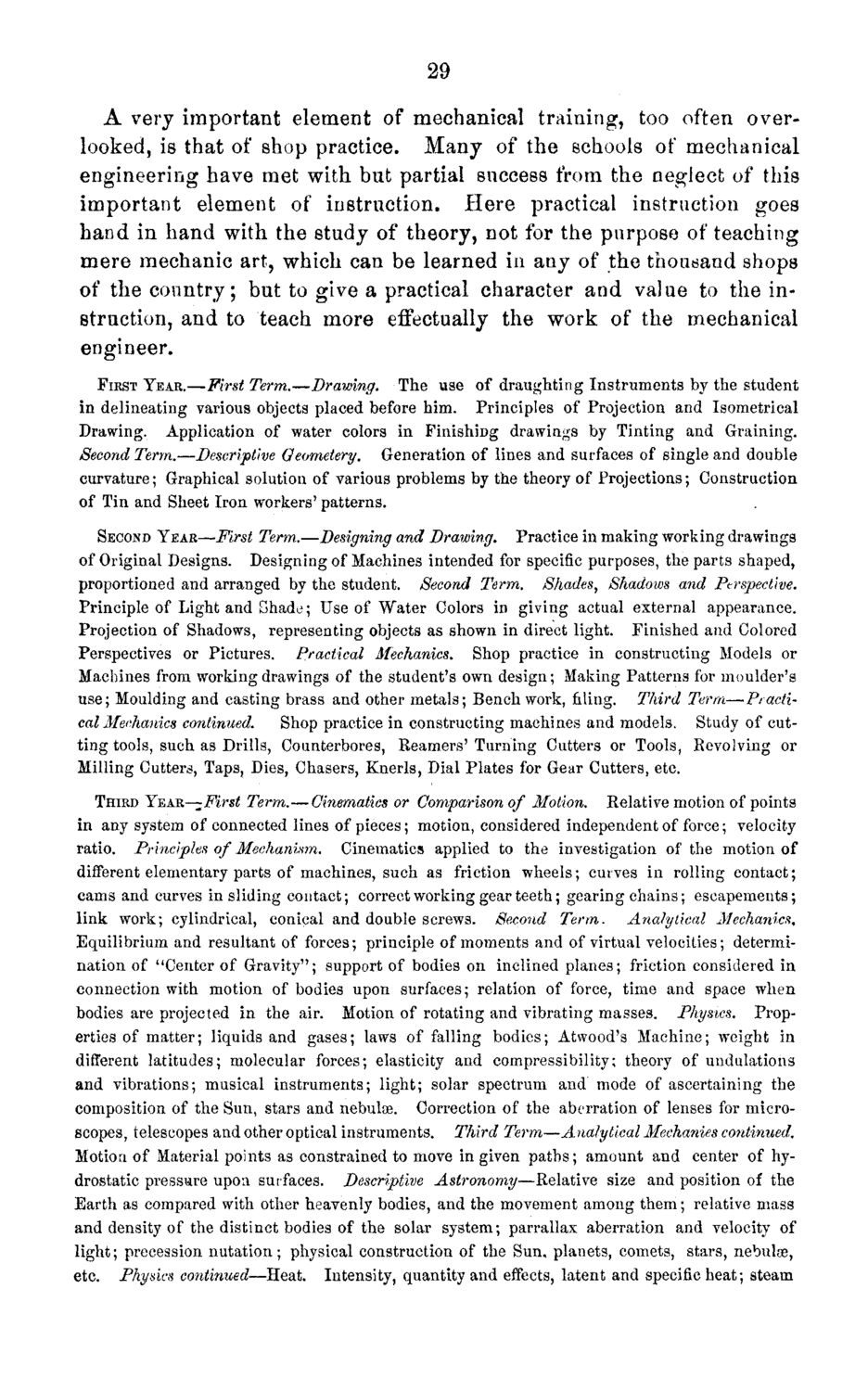| |
| |
Caption: Board of Trustees Minutes - 1871
This is a reduced-resolution page image for fast online browsing.

EXTRACTED TEXT FROM PAGE:
29 A very important element of mechanical training, too often overlooked, is that of shop practice. Many of the schools of mechanical engineering have met with but partial success from the neglect of this important element of instruction. Here practical instruction goes hand in hand with the study of theory, not for the purpose of teaching mere mechanic art, which can be learned in any of the thousand shops of the country; but to give a practical character and value to the instruction, and to teach more effectually the work of the mechanical engineer. FIRST YEAR.—First Term.—Drawing. The use of draughting Instruments by the student in delineating various objects placed before him. Principles of Projection and Isometrical Drawing. Application of water colors in Finishing drawings by Tinting and Graining. Second Term.—Descriptive Geometery. Generation of lines and surfaces of single and double curvature; Graphical solution of various problems by the theory of Projections; Construction of Tin and Sheet Iron workers' patterns. SECOND YEAR—First Term.—Designing and Drawing. Practice in making working drawings of Original Designs. Designing of Machines intended for specific purposes, the parts shaped, proportioned and arranged by the student. Second Term. Shades, Shadows and Perspective. Principle of Light and Shade; Use of Water Colors in giving actual external appearance. Projection of Shadows, representing objects as shown in direct light. Finished and Colored Perspectives or Pictures. Practical Mechanics. Shop practice in constructing Models or Machines from working drawings of the student's own design; Making Patterns for moulder's use; Moulding and casting brass and other metals; Bench work, filing. Third Term—Practical Mechanics continued. Shop practice in constructing machines and models. Study of cutting tools, such as Drills, Counterbores, Reamers' Turning Cutters or Tools, Revolving or Milling Cutters, Taps, Dies, Chasers, Knerls, Dial Plates for Gear Cutters, etc. THIRD YEAR—i^rstf Term.— Cinematics or Comparison of Motion. Relative motion of points in any system of connected lines of pieces; motion, considered independent of force; velocity ratio. Principles of Mechanism. Cinematics applied to the investigation of the motion of different elementary parts of machines, such as friction wheels; curves in rolling contact; cams and curves in sliding contact; correct working gear teeth; gearing chains; escapements; link work; cylindrical, conical and double screws. Second Term. Analytical Mechanics, Equilibrium and resultant of forces; principle of moments and of virtual velocities; determination of "Center of Gravity"; support of bodies on inclined planes; friction considered in connection with motion of bodies upon surfaces; relation of force, time and space when bodies are projected in the air. Motion of rotating and vibrating masses. Physics. Properties of matter; liquids and gases; laws of falling bodies; Atvvood's Machine; weight in different latitudes; molecular forces; elasticity and compressibility; theory of undulations and vibrations; musical instruments; light; solar spectrum and mode of ascertaining the composition of the Sun, stars and nebulae. Correction of the aberration of lenses for microscopes, telescopes and other optical instruments. Third Term—Analytical Mechanics continued. Motion of Material points as constrained to move in given paths; amount and center of hydrostatic pressure upon surfaces. Descriptive Astronomy—Relative size and position of the Earth as compared with other heavenly bodies, and the movement among them; relative mass and density of the distinct bodies of the solar system; parrallax aberration and velocity of light; precession nutation; physical construction of the Sun, planets, comets, stars, nebulce, etc. Physics continued—Heat. Intensity, quantity and effects, latent and specific heat; steam
| |